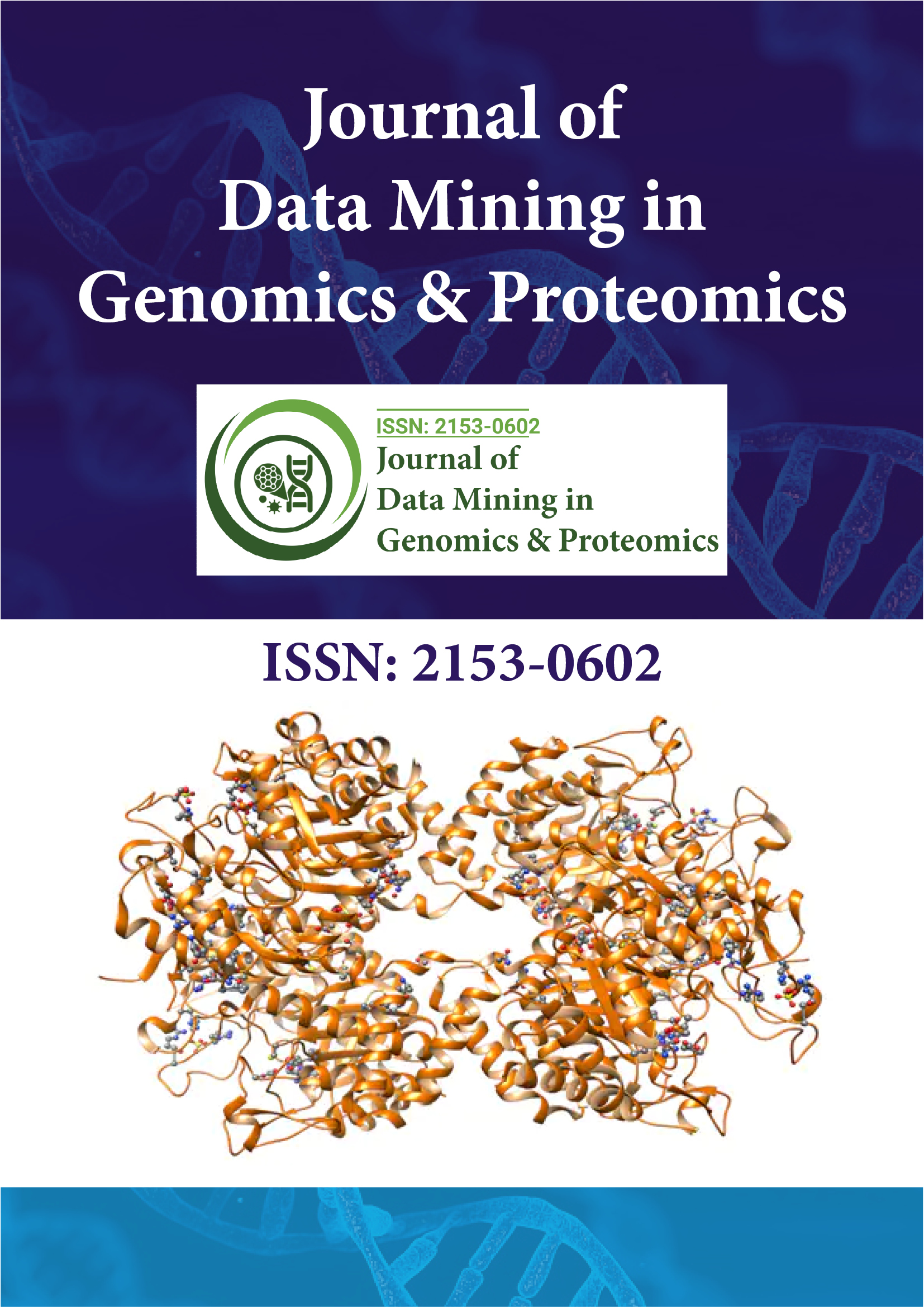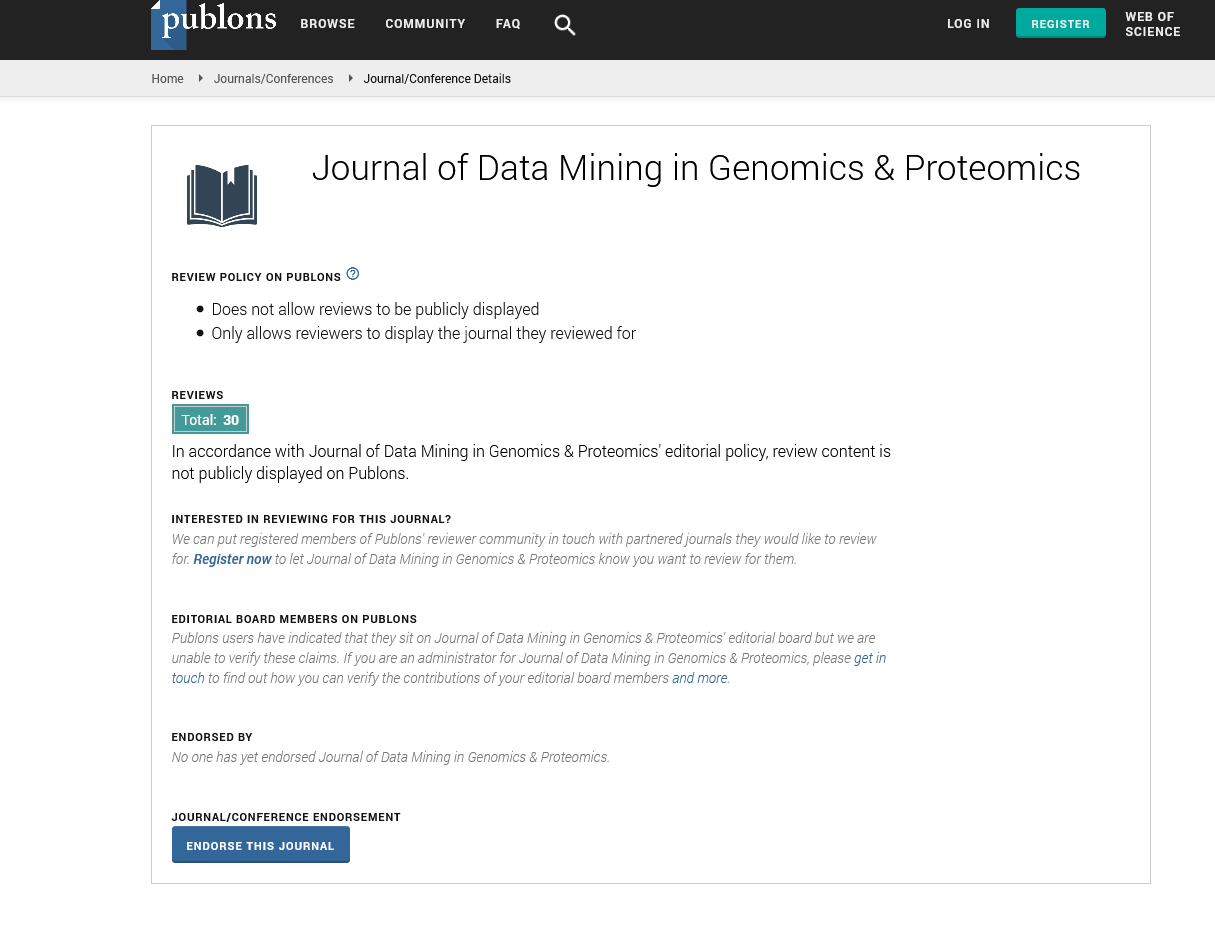Indexed In
- Academic Journals Database
- Open J Gate
- Genamics JournalSeek
- JournalTOCs
- ResearchBible
- Ulrich's Periodicals Directory
- Electronic Journals Library
- RefSeek
- Hamdard University
- EBSCO A-Z
- OCLC- WorldCat
- Scholarsteer
- SWB online catalog
- Virtual Library of Biology (vifabio)
- Publons
- MIAR
- Geneva Foundation for Medical Education and Research
- Euro Pub
- Google Scholar
Useful Links
Share This Page
Journal Flyer

Open Access Journals
- Agri and Aquaculture
- Biochemistry
- Bioinformatics & Systems Biology
- Business & Management
- Chemistry
- Clinical Sciences
- Engineering
- Food & Nutrition
- General Science
- Genetics & Molecular Biology
- Immunology & Microbiology
- Medical Sciences
- Neuroscience & Psychology
- Nursing & Health Care
- Pharmaceutical Sciences
Perspective - (2022) Volume 13, Issue 3
Major Applications of Data Mining in Genomics and Proteomics
Magnus Back*Received: 02-May-2022, Manuscript No. JDMGP-22-17217; Editor assigned: 04-May-2022, Pre QC No. JDMGP-22-17217 (PQ); Reviewed: 18-May-2022, QC No. JDMGP-22-17217; Revised: 25-May-2022, Manuscript No. JDMGP-22-17217 (R); Published: 02-Jun-2022, DOI: 10.4172/2153-0602.22.13.252
About the Study
There is no question that the future of biological research will be highly influenced by computational biology, bioinformatics, and the intersection of computer science and biology in general. Data collection, analysis, categorization, and integration are the first steps in the process, which culminates with interpretation, modeling, visualization, and prediction. In the course of this procedure, data mining is involved. In general, the emphasis is on locating opportunities and creating computational tools (such as algorithms, models, tools, and databases) that may be utilized for hypothesis formulation, data analysis, and experimental design.
Finding hidden trends in huge data sets is known as data mining. At all levels of genomics and proteomics investigations, data mining techniques are required. Through the study of biological samples from both healthy and diseased tissues, these investigations can quickly provide enormous amounts of data and offer a wealth of information. The enormous dimensionality of the data produced by these investigations will necessitate the improvement of computational biology and bioinformatics tools for quick and reliable data analysis.
The rapid advancements in genomes and proteomics over the past few years have produced a lot of biological data. Complex computational analyses are needed to draw inferences from these data. Computational biology, often known as bioinformatics, is an interdisciplinary field of study that uses computer science and information technology to understand biological data. As we continue to produce and incorporate massive amounts of genomics, proteomics, and other data, the significance of this new area of study will increase.
The use and development of data mining tools to address biological issues is a particularly active field of bioinformatics study. Making sense of massive biological data sets by inferences of structure or generalization’s is necessary for analysis. Examples of this kind of analysis include statistical modeling of proteinprotein interaction, protein structure prediction, gene categorization, cancer classification based on microarray data, clustering of gene expression data, etc.
The use of computer technology in the administration of biological data is known as bioinformatics. The science of storing, collecting, organizing, analyzing, interpreting, and using data from biological sequences and molecules is known as bioinformatics. The development of DNA sequencing and mapping methods has been its key driver. Quick advancements in information technology over the past few decades have joined with rapid advancements in genomic and other molecular research methods to produce an enormous volume of molecular biology-related information. Increasing our understanding of biological processes is the main objective of bioinformatics.
Data mining and bioinformatics are becoming interdisciplinary fields of study. Since bioinformatics is data-rich yet lacks a thorough understanding of how life is organized at the molecular level, data mining techniques seem to be the perfect fit for the field. The size, quantity, diversity, absence of a standardized ontology to facilitate querying, and diverse data of the quality and provenance information they contain are some of the biological databases' drawbacks that prevent data mining in bioinformatics from being effective. Another issue is the wide range of levels of topic expertise among potential users, making it challenging for database curators to create an access method that is suitable for everyone. Another issue is the integration of biological databases. Today's research fields in data mining and bioinformatics are expanding quickly. It is crucial to assess the key research questions in bioinformatics and create new data mining techniques for efficient and scalable analysis.
Citation: Back M (2022) Major Applications of Data Mining in Genomics and Proteomics. J Data Mining Genomics Proteomics. 13:252.
Copyright: © 2022 Back M. This is an open-access article distributed under the terms of the Creative Commons Attribution License, which permits unrestricted use, distribution, and reproduction in any medium, provided the original author and source are credited.

